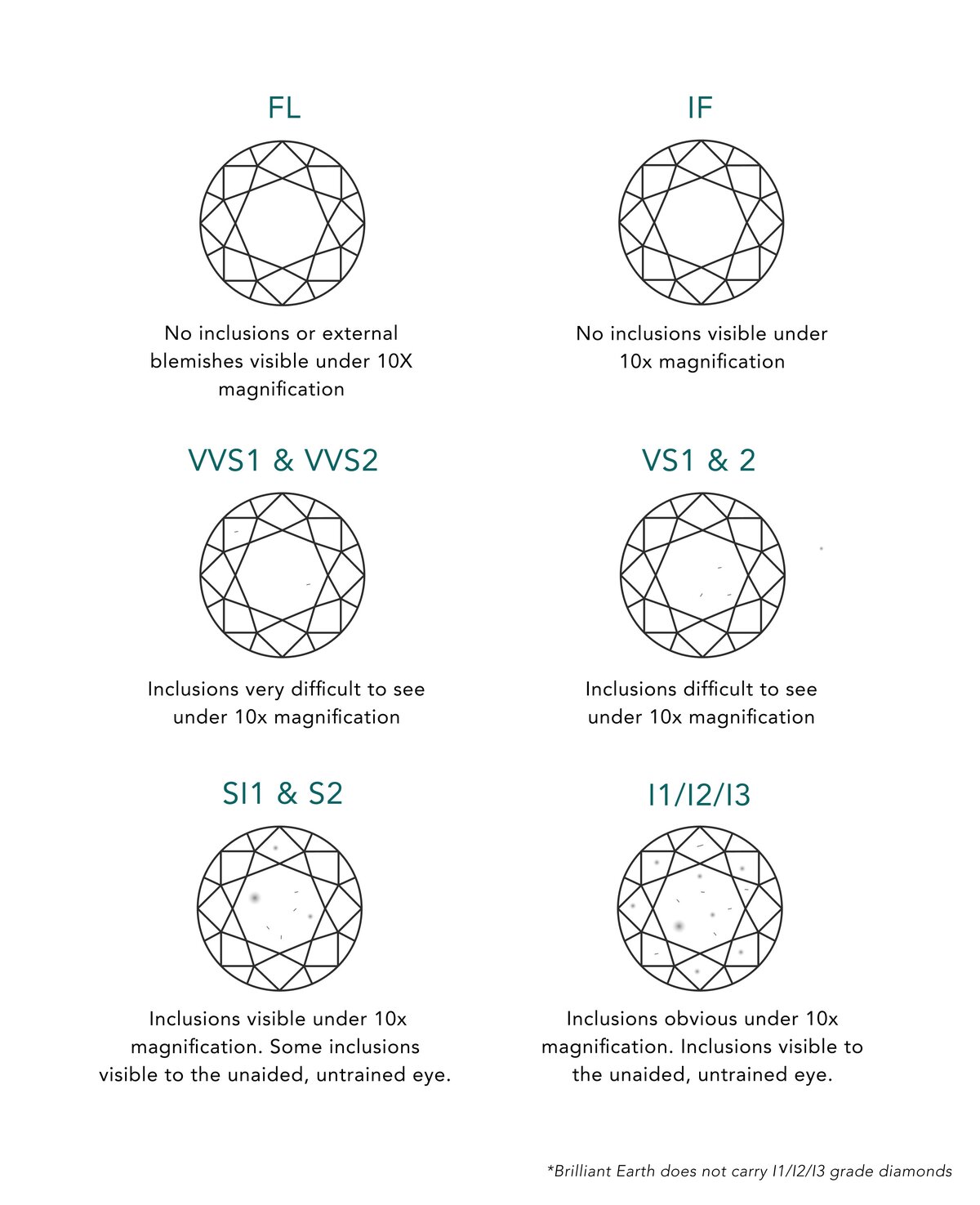
Diamond Clarity
Diamond clarity measures the presence of internal (inclusions) and external (blemishes) imperfections in both natural and lab-grown diamonds. These characteristics develop during formation — either naturally under the Earth's pressure and heat or during the lab-growing process — or during subsequent cutting, polishing, and wear. A diamond's clarity grade, ranging from Flawless to Included, indicates how noticeable these imperfections are under 10x magnification, though many are invisible to the naked eye.
Diamond Clarity Scale
The Gemological Institute of America (GIA) established the industry-standard 4 C's (cut, color, carat, and clarity) in 1953. Their diamond Clarity Scale consists of 6 categories with 11 levels, ranging from Flawless to Included. Professional graders use 10x magnification to examine each diamond's imperfections, assigning a clarity grade that becomes part of the gem’s certification report.
Flawless (FL)
- No inclusions and no blemishes visible under 10x magnification when viewed face up. Less than 1% of all diamonds are FL clarity, as it is nearly impossible to find a diamond that is completely inclusion and blemish-free.
- Flawless diamonds are eye clean.
- Shop Flawless Diamonds
Internally Flawless (IF)
- No inclusions are visible under 10x magnification. Some small surface blemishes may be present under a microscope.
- Internally Flawless diamonds are eye clean.
Very, Very Slightly Included (VVS1 and VVS2)
- Inclusions are characterized as minute and are so slight that they are difficult for a skilled grader to see under 10x magnification.
- VVS1 and VVS2 diamonds are eye clean.
Very Slightly Included (VS1 and VS2)
- Inclusions are observed with effort under 10x magnification but can be characterized as minor.
- VS1 and VS2 diamonds are generally eye clean.
Slightly Included (SI1 and SI2)
- Inclusions are noticeable under 10x magnification.
- Some SI1 and SI2 diamonds may have inclusions that are detectable to the unaided, untrained eye, while others do not.
- Shop SI1 Diamonds
Included (I1, I2, and I3)
- Inclusions are obvious under 10x magnification, which may affect transparency and brilliance.
- Brilliant Earth does not carry Included grade diamonds as their imperfections are generally visible to the unaided, untrained eye.

Diamond Clarity Chart
The GIA clarity grading system evaluates diamonds using standardized viewing conditions and specific criteria, as illustrated in the clarity chart below.

Diamond Clarity Grading
Professional gemologists evaluate diamond clarity through a systematic process. Using 10x magnification and standardized lighting, they assess each imperfection's characteristics:
- Size: Larger inclusions have greater impact
- Number: More inclusions typically lower the grade
- Position and location: Table (center) inclusions affect grade more significantly
- Nature: Type and severity of each inclusion
- Relief: Contrast between inclusion and diamond
After examining all inclusions and blemishes, graders plot them on a diagram to map the diamond's unique characteristics. This comprehensive assessment determines the final clarity grade.

Diamond Clarity Characteristics: Inclusions & Blemishes
Natural and lab grown diamonds develop distinct internal characteristics through fundamentally different processes. In natural diamonds, extreme heat and pressure transform carbon deep within Earth over billions of years, trapping various materials that become visible inclusions — primarily pinpoints (tiny dots) and feathers (small internal breaks). While lab diamonds develop similar physical features during their accelerated growth, grading terminology shifts between natural and lab reports; what GIA calls a "pinpoint" in natural diamonds might appear as a "growth remnant" in lab diamond documentation, reflecting their different formation stories rather than different inclusion types.
Both lab and natural diamonds can develop external imperfections (blemishes) after formation, typically during cutting, mounting, or wearing. The most common internal inclusions include cavities (angular openings from extended breaks), clouds (hazy pinpoint clusters), crystals (mineral deposits), feathers (white, crack-like formations), graining (whitish or reflective lines), needles (rod-like crystals), knots (surface-reaching crystals), and pinpoints (microscopic dot-like crystals). Common external blemishes include abrasions (edge nicks creating fuzzy white areas), chips (shallow surface openings), naturals (remnants of the original rough diamond), nicks (small girdle notches), pits (tiny white dots), rough girdles (granular perimeter surfaces), and scratches (thin white surface lines).
Diamond Clarity Tips
Choosing the perfect diamond requires balancing the 4 C's with your preferences and budget. When considering clarity:
- Prioritize an Eye-Clean Look: Focus on eye-clean appearance rather than technical grade. While Flawless is the highest grade, consider starting with SI1, SI2, VS1, or VS2 diamonds, which often appear eye-clean at significantly lower costs than higher grades.
- Match Size to Clarity: Larger diamonds require higher clarity grades since inclusions become more visible with size. Balance your budget between size and clarity based on your priorities.
- Consider Cut Style: If you're hoping to purchase a diamond with rectangular or step-cut facets, such as an asscher or emerald shape, you'll benefit from a higher clarity grade, as these cuts emphasize transparency and allow you to see deeper into the diamond.
- Examine in Person: Make an appointment to view diamonds in person when possible, as inclusions appear differently than in photos or videos.
- Check Inclusion Placement: Consider inclusion location, as settings can hide certain imperfections.
- Factor in Shape: Oval, cushion, radiant, marquise, and pear-shaped diamonds hide clarity flaws better than others due to their brilliant faceting.

How Important Is Diamond Clarity?
Clarity plays an important role in a diamond's overall quality and value. A diamond's clarity characteristics affect not only its appearance but also its durability and price point.
A diamond's clarity significantly impacts:
- Visual Appeal and Brilliance: Included diamonds may appear duller and less brilliant
- Structural Integrity: Large or numerous inclusions can affect durability and increase the risk of chipping
- Light Performance: Severe inclusions can interfere with how light travels through the diamond
While Flawless and Internally Flawless diamonds command premium prices due to their rarity, eye clean or Slightly Included diamonds offer excellent value and remain a popular choice for most customers. The key is finding the right balance between clarity grade and other factors that affect a diamond's overall quality and beauty.
Diamond Clarity FAQ
What is the best diamond clarity?
The highest quality clarity grade of diamonds is Flawless. These diamonds have no inclusions or blemishes at 10x magnification and are very rare. However, VS2 and above are typically considered excellent choices as they appear clean to the naked eye at significantly lower prices.
What is diamond clarity?
Diamond clarity measures the presence or absence of inclusions and blemishes, graded on a scale from Flawless to Included (I3).
What is a good diamond clarity?
VS2 and above are considered good clarity grades, offering excellent value while appearing clean to the naked eye. Some Slightly Included (SI) diamonds may also appear eye clean.
What does diamond clarity mean?
Clarity refers to how free a diamond is from inclusions and blemishes, both internally and externally.
What is a clarity enhanced diamond?
A clarity enhanced diamond is a diamond that was treated with laser drilling or fracture filling. Brilliant Earth does not carry clarity enhanced diamonds.
What diamond clarity is eye clean?
Diamonds that have inclusions or blemishes that are not visible to the naked eye are considered 'eye clean.' Most VS2 and higher clarity diamonds are eye clean. Some SI diamonds can also be eye-clean, depending on the specific inclusions.
What clarity diamond is best for an engagement ring?
VS2 to SI1 typically offers the best value for engagement rings, providing an eye-clean appearance at a reasonable price point.
What's more important in a diamond, color or clarity?
Clarity is the absence or presence of inclusions in and blemishes on the surface of a diamond. Diamond color references the absence of color in a diamond. Both are important, but priority depends on personal preference and diamond characteristics.
How does diamond clarity affect a diamond’s price?
Generally speaking, all factors being equal, the higher the clarity of a diamond, the more expensive it'll be.
Does clarity apply to side stones and accent diamonds?
Yes, clarity still applies to side stones, though melee and accent stones are not typically graded by gemological labs. If you're designing your own ring, consider matching the accent clarity to your center stone or go a few clarity grades lower.

















